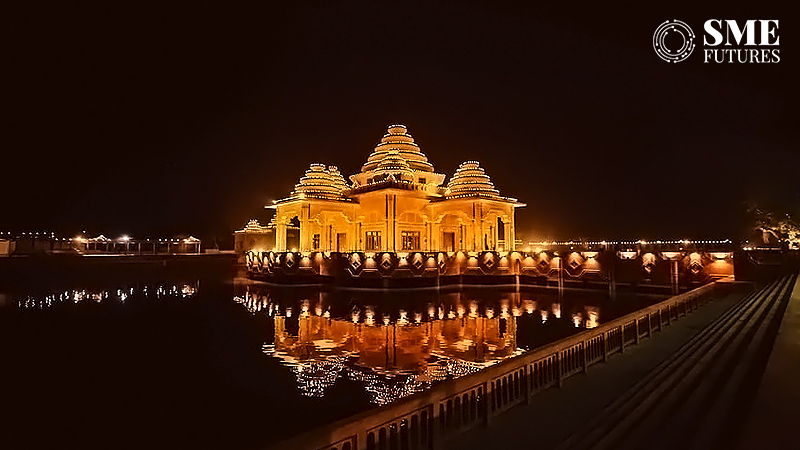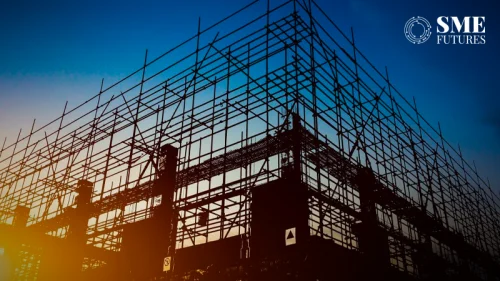As the world witnessed the spectacular moments of Ram Mandir’s consecration ceremony, it is imperative to talk about those who played a key role in the meticulously planned creation of the temple and the makeover of the city. Ram Mandir of Ayodhya with an estimated cost of Rs 1800 cr ranks second in the list of most expensive public monuments constructed in recent years after the Statue of Unity (2989 Cr).
The Uttar Pradesh government will carry out projects totaling Rs 85,000 crores to upgrade the town’s infrastructure as part of the Ayodhya Master Plan 2031. A redesigned railway station and a new international airport have already been unveiled by the administration.
Leading corporate houses in the nation, including airlines, hotel operators, and real estate developers, are making their way to the temple town.
Let us analyse the roles of major companies/MSMEs in making the event a success.
Companies involved in Ram Mandir construction
In November 2020, the temple construction committee set up by the Shri Ram Janmabhoomi Teerth Kshetra Trust appointed engineering and construction giant L&T along with Tata Consulting Engineers as the design & build contractor and project manager consultant for the development of Ram Mandir in Ayodhya.
Larsen & Toubro (L&T): Leading Indian engineering and infrastructure firm Larsen & Toubro (L&T) offered its expertise in the construction of Ram Mandir. L&T has been delegated to manage the project from concept to completion, providing its extensive experience and technical know-how at no cost. The general secretary of Ram Janmabhoomi Teerth Kshetra, Champa Rai, stated that the idea to build Ram Mandir was discussed with L&T fifteen years ago.
Tata Consulting Engineers Limited (TCEL): The Shri Ram Janmabhoomi Teerth Kshetra Trust hired Tata Consulting Engineers Limited (TCEL) as their project management consultant to ensure seamless and effective project management. Due to TCEL’s extensive experience overseeing major infrastructure projects, every facet of construction—from the acquisition of materials to the distribution of labor is carefully planned and carried out.
Indian Institutes of Technology (IITs): The prestigious Indian Institutes of Technology (IITs) in Bombay, Guwahati, and Madras are contributing their knowledge in several fields, such as material science, structural engineering, and earthquake-resistant design. Their cooperation makes the temple a masterwork of both structural durability and visual beauty by incorporating both traditional architectural elements and state-of-the-art technology.
The project involves thousands of artists, craftsmen, labourers, and engineers who are giving it their all. Every stone carved, every pillar built, and every complex architectural feature realised are examples of their commitment and attention to detail.
Central Building Research Institute (CBRI): Any building’s foundation is important, but Ram Mandir’s is even more so. To guarantee the temple’s stability for many generations to come, thorough soil testing and analysis have been carried out by the CBRI. Their analysis and suggestions direct the building process, guaranteeing the temple’s durability. “CSIR-CBRI has been involved in the Construction of Ram Mandir since early 2020,” the organisation states in a LinkedIn post.
The following have been supplied by the institute: The main temple’s structural design, the Surya Tilak mechanism, the foundational design review, and the structural health monitoring of the main temple are all addressed in order.
National Geophysical Research Institute (NGRI): Understanding the geological composition of the site was made possible in large part by the National Geophysical Research Institute (NGRI). By employing sophisticated geophysical methods, they mapped the underlying strata, detected possible hazards, and offered insightful information to the building crew. Their knowledge lessens the likelihood of any unforeseen geological difficulties impeding the project’s advancement.
Companies involved in infrastructure building of Ayodhya City
Other Indian companies like Havells India, Pakka, SIS, Allied Digital Services, Genesys International, and Apollo Sindoori Hotels have key roles in the Ayodhya and Ram Mandir project, including lighting, compostable products, security, surveillance, mapping technology, and parking facilities.
Havells India has provided lighting solutions on the temple premises. The company is installing linear in-ground lights, spot in-ground lights, and 24-carat gold-plated spotlights around the idol of lord Rama in the temple.
Allied Digital Services Limited has been selected as a Master System Integrator (MSI) for the integration of CCTV surveillance with the existing ITMS control room for the Ayodhya Smart City Project.
Digital mapping company Genesys International Corporation Ltd was selected to create the official map for Ayodhya city by the Ayodhya Development Authority.
The Shri Ram Janmabhoomi Teerth Kshetra Trust has partnered with Pakka to use compostable plates, bowls, and spoons within the temple premises. Pakka’s flagship brand, CHUK, known for its compostable tableware, will exclusively distribute tableware before and after the Ayodhya Mandir inauguration event.
Private security group SIS Ltd has signed an agreement with Ram Mandir Trust to deploy its personnel at the temple complex in Ayodhya.
Apollo Sindoori Hotels Chennai-based hospitality management services is constructing a multi-level parking facility in Ayodhya to accommodate visitor vehicles.
A Kerala-based company called Indian Centrifuge Engineering Solutions Pvt Ltd (ICF) was assigned the task of constructing 500-plus bio-toilets in Ayodhya.
Service providers aided temple inauguration and smooth functioning
Staqu Technologies, a Gurgaon-based Artificial Intelligence startup, installed its AI-powered audio-video analytics software called Jarvis, in the existing cameras in Ayodhya for better security on the inauguration event.
Another company called Mirasys (India), an AI-based video surveillance & analytics leader played a pivotal role in ensuring the same. The company deployed its AI video surveillance systems on more than 500 cameras across the premises and perimeter of Ram Mandir and other key points across Ayodhya, safeguarding all the entrance and exit points.
Dairy company Nova Dairy provided 100 tonnes and 1500 kg of ghee for the preparation of the prasad (offerings) at the Pran Pratishtha ceremony.
The maker of Coca-Cola, Fanta, and Sprite has placed 50 reverse vending machines in the city to help curb pollution.
Ayurveda major Dabur India decided to donate a portion of the profits from all Dabur products sold between 1st January and January 31 to Shree Ram Janmabhoomi Teerth Kshetra.
ITC’s agarbatti (incense sticks) brand spearheaded a series of initiatives to be a part of the celebrations. On the day of the inauguration, the brand installed a ‘Khushboo Path’ within the temple premises.
Ride-hailing firm Uber has started its electric auto-rickshaw service in Ayodhya under its popular category, Uber Auto.
The massive investments and corporate pledges, it seems, are going to make the city of Ayodhya one of the biggest pilgrimage sites for the Hindus in the time to come.











